|
While you internet viewers have probably seen all of the pages presenting the exclusive projects that we've been working
on, there are also those little things that we do around the homestead that deserve at least some honorable mention, since
even the little projects play a pivotal role in the success of the homestead. Since most of these projects are so small
that we may only have one or two pictures of any given thing we finish, they will be documented on here based on their completion,
with the topmost ones being the first to be completed, then working our way down. So enjoy!
WOODEN WALKWAY
This simple little setup came about after getting tired of plodding through the endless mud puddles that seem to remain
during the rainy season (winter). Since this whole area is all dirt and small patches of grass, the area is pretty messy
all the way up to the house. I personally get tired of always having to walk in with my boots covered in mud, transferring
it to the house or truck, or wherever else I walk, so my solution - build a walkway from the "driveway" to the stairway of
the porch for walking on, so at least when I'm walking from the house to the truck and back, I don't make a big mess.
As far as when we're working on crap outside, thats a different story for a different day.
The walkway is pretty simple, just two 2x4 boards laying side by side about 2 feet apart, with some boards that are about
an inch thick x 6 " wide (Lowe's didn't classify them as 1x6's they had some other oddball size on them) laid across the 2x4s
and spaced about 2" apart. The walkway stretches for a good 26' from the porch to the driveway where it ends on solid
ground right at the edge of the gravel.
This walkway works very good in that there are no more muddy boots whenever I come home from the job.
Even in the worst rain when the rest of the yard has turned in to a swamp, the walkway serves its purpose as a bridge to the
house. One may wonder why not just dump gravel down over all of this, well first of all, gravel only comes by a
dump truck load, which would be reserved for driveways or the like. Secondly, the ground has some trenches that
we dug a year ago to divert rainwater around the house's foundation. and putting gravel all over that area would allow for
rainwater to more easily run under the house, washing away the dirt under the pilings. This was cheaper then trying
to do any kind of setup with gravel or bricks or any other rock based material. Even with gravel down, rain would've
still washed over it causing the gravel to sink in the mud and creating a mess all over again. This way, our feet stay
clean, but again, when we work in the "driveway area" where all the cars and their associated crap lay, we're on our own.
Now if only we can get some gravel.....
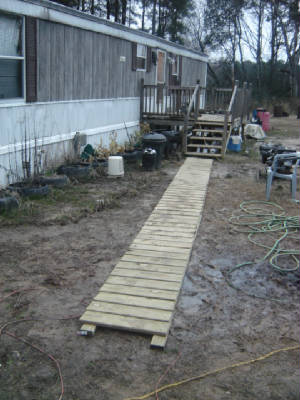
|
| Wooden walkway from the driveway to the house |
STORAGE CRATE FOR ENGINE
This little project stems from the desire to try and save an engine that we do plan on utilizing in the future for another
vehicle project, one that we acquired real cheap not too long ago. Last year sometime we picked up a Mercedes OM617
5 cyl diesel engine w/turbo for $50 from a local man from craigslist. The engine is supposedly in running condition,
just needs a wee bit of reassembly (gaskets, linkages, hoses). Anyway, the engine has been sitting outside for most
of the year, and after seeing what happened to the 351 engine that came out of the 69 mustang after it sat outside for a while
(rusted all to hell), we decided that if we're gonna keep this engine, we're gonna have to protect it from the elements somehow.
That's where the crate comes in. Since merely covering it will not work, this engine needs to be totally isolated
from the moisture that would inevitably make its way into the engine, rusting it out as well. We figured that if we
throw together a crude wood box and caulk it up from the inside to make it water tight, then put the engine inside and cap
it off, finishing it with more caulk to totally seal it up, then the engine should remain just as safe as it would sitting
in a warehouse or garage until we decide its time to use it again.
In order to do this we took one of the salvaged pallets from our firewood pile, a pallet that happened to be exactly
the size we needed to put the engine on. We then cut a piece of plywood and screwed it to the top of the pallet for
the floor of the box, then followed with four 2x4's that were screwed to the four corners of the box vertically. Afterwards
we then measured and cut four more pieces of plywood to screw in place for walls.
With the box made, except for the top, we then caulked the inside up real good and moved the box near where its final
resting place will be. Next we put the engine crane into position around the engine and backed the truck up, lifting
the engine into the back of the truck, then moving the truck over to where the crate is at, and moving the crane over to that
location to remove the engine from the truck. Now since the crate was wider than the opening between the legs of the
crane, we literally had to use several pieces of scrap wood to make a base to suspend the box above the legs of the crane,
so we can then lower the engine into the box and remove the crane from the site of the box. With that we cut a final
piece of plywood to serve as the lid, screwing it in place and using a couple of angle braces on two of the sides where the
warped board rose up a little bit. This was to bring the board closer to the top surface of the vertical boards, so
when we did the final caulking of the lid, we were able to get a good seal without using a lot of caulk.
With the completion of the crate, which is still sitting on the wood supports, the engine is now ready for long term
storage, we don't have to worry about trying to hurry up with other projects so we can get to a project involving this engine,
nor do we have to go and sell the thing off in order to get our money back, knowing we won't find another deal like that again
in a million years.
The only other thing that we will probably do to the crate is use up this outdoor white roofing paint that we still have
left over from painting the shed, to further protect the crate and help it last a good long time before we need to give it
any attention, maybe by that time we will be done with our other projects that we will be ready to start a diesel project
exclusively and crack the crate open to use this engine.
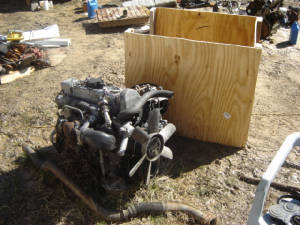
|
| Shot of engine with unfinished crate. |
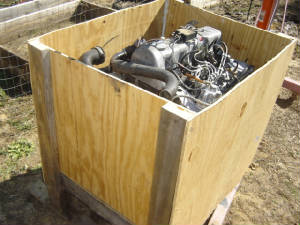
|
| Shot of engine inside near completed crate |
GO KARTS
We recently acquired three go karts that were in various states of disrepair for a cheap trade, along with several dead
engines, with the intent of restoring operation to all of the vehicles, keeping one of them and selling the other two.
The intent of keeping one of the go karts was to use the vehicle for our pending hydrogen generator experiments, before creating
full size apparatus for the regular cars.
The first kart we got back up and running is a two seater for smaller kids, a one seater for any average adult.
It has a 5 hp Briggs engine and a roll bar behind the driver's seat. After cleaning the carb and changing the oil we
were able to get the vehicle back up and running. Once the engine was running we took the kart for some test drives.
When the engine stays running, that fucker really moved! With a good tire on the drive side, that kart would've really
ran like a bat out of hell! The only flaw the engine has is that it doesn't idle at a reasonable rpm at times and will
sometimes stall out then be a bitch to start back up. The kart also received a complete spray painting to make it look
a lot better as well.
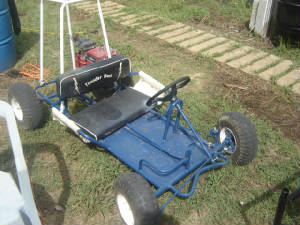
|
| The first go kart completed |
The second kart is a larger black kart with two seats that look like they will accomodate two adults snugly. This
one had a 5 hp Tecumseh available but the engine is missing the carb, exhaust and air filter housing, as well as the seat
panels. The first thing that was done was the acquisition of a 6.5 hp engine from Harbor Freight after finding a coupon
to get the engine for $100. The seats are temporarily replaced with plywood panels for the time being until we can acquire
some real go kart seats. This kart also received a good spray of black paint. Despite the throttle cable being
a little stiff, this kart is able to get up to speed pretty good too, not like the other one, yet. A new throttle cable
is on order along with a new drive tire since the current one is bald as hell. This kart also had a roll cage but it's
been removed. We will probably get some conduit to fabricate a better one, just for decoration if anything. Another
plan that I suddenly came up with was to fabricate a gas fuel mixer to bolt to the Tecumseh in place of the carb, along with
a homemade exhaust pipe if I don't decide to just buy a cheap muffler. That engine will serve as the experimental gaseous
fuel test engine, for propane and hydrogen, among other gaseous fuels.
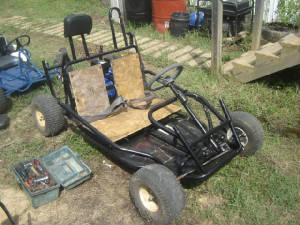
|
| The black kart all fixed up |
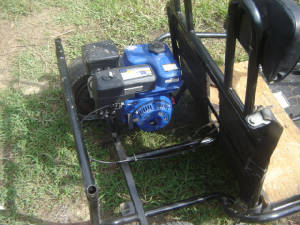
|
| The black kart's new engine |
The last go kart is a small kiddie two seater (one seater adult) that's pretty much the smallest one of the group.
This one would've had a 5 hp engine, but the engine that was chosen was unable to be resurrected, even with the aid of parts
from the spare engines, it was a lost cause. We ended up getting a cheap 3.5 hp Briggs engine from a guy off of Craigslist,
and having to use the carb and fuel tank from one of the dead engines to resurrect this little engine. I figured the
3.5 hp engine would be more than sufficient for this small kart due to the fact that a go kart for little kids shouldn't be
able to run past the speed of light. This kart will be getting a fresh chain to get things off and running. A
paint job and switching of the drive tires for one of the good tires on the kart will further complete this kart.
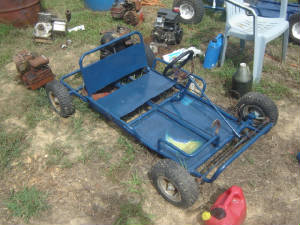
|
| Last but not least, the baby |
With that, the three karts are complete with ours soon to be ready and the other two ready for sale after the couple
of little things get done. The money will help us further pursue our other endeavors.
12V FLUORESCENT TUBE LAMP DRIVER/FIXTURE
This little project is nothing more than an old tube fluorescent light fixture that was recycled from the
scrap heap and rigged up with a homemade 12v driver circuit that consists of a high frequency inverter using a PNP and NPN
power transistors putting a square wave AC current into the secondary coil of a 120 to 3v transformer, delivering well over
200v at the primary coil, more than enough to ionize the fluorescent material in the tube. Granted the bulb doesn't
light as bright as it does when powered by a typical 120v ballast, it does light good enough to light the area within our
pallet fuel shed. The fixture will be wired to a small 12v battery, probably a lawn mower battery as I can get one pretty
cheap, and activated by a simple switch box mounted on the inside of the shed. A solar panel will be remotely mounted
in an area where it can pick up sunlight to recharge the battery, creating another solar powered system for one of our structures
on the homestead.
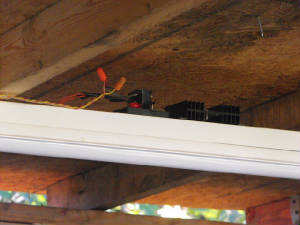
|
| Shot of fluorescent fixture, note heat sinks and circuit. |
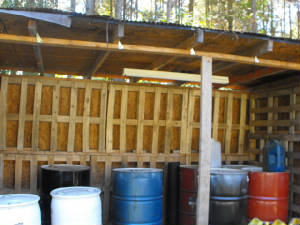
|
| Shot of shed with light fixture in place |
OIL DRUM DOG HOUSE
Here's another simple little build that killed two birds with one stone, a simple dog house built
using materials that are considered scrap or trash in most circles. In this case, an old oil drum and a pallet are the
main components of this setup, along with a couple of short cuts of 2x4's.
This simple setup came to be out of need for a shelter for a stray dog that came to our property
and just didn't really want to leave. Nevermind the idea that the dog was nice as he wants to be and you almost couldn't
help but be friends with him, which just solidified his desire to stay. Also no one was interested in taking him off
our hands so we just said screw it and kept him here, he does make a good early warning system so he's at least earning his
keep. But he needed a more permanent house.
We used an old oil drum that was part of an old chicken tractor project that fell apart after
a while, and since we planned on using the same drum for our new chicken tractor (posted on another page on this site), we
needed to set something up for ole Dickhead (yeah I named the dog Dickhead).
The oil drum doghouse is simple, I drilled four holes in what is to be the bottom of the house,
then drove four screws through the holes into the pallet boards to anchor the drum down. Next I took two short 2x4's
(approx. 1.5 ft long) and drilled a couple more pilot holes on the sides of the drum with which to drive wood screws through
to hold the boards on at an angle. Some more long wood screws drilled in at an angle at the bottom of the 2x4's into
the pallet boards further secured the boards together, making for a solid bracing that holds the oil drum nice and tight.
A doorway was cut into the "top" of the oil drum long before this was started and all oil residue
was removed. A wood fire was started in the drum to burn off any remaining residue then everything was rinsed out prior,
so no worry folks about the doggie getting sticky or sick from old oil. What I did do though to protect the dog from
getting cut on the edges of the "doorway" was to take some fuel hoses, cut them lengthwise and slide the pieces over the edges
to serve as cushions to keep the dog from scraping against the sharp metal.
Overall this simple setup works out, DIckhead took to his new house pretty quickly. It
was a lot cheaper than spending $60+ for one of those igloo dog houses or any other large plastic doghouse.
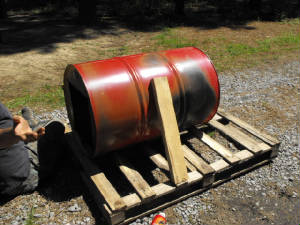
|
| The completed oil drum dog house |
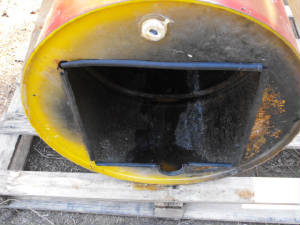
|
| Closeup of fuel hose bumpers around edges of doorway |
THE JUNKER AIR COMPRESSOR
This was a little pet project that I worked on as a means to take care of some extra junk we had lying
around the 'stead. We had two air compressors, one small one, like one of those little ones you use for nailguns, has
a tank on it of maybe a gallon or two in capacity, and a larger compressor with probably an 8 gallon tank on it. The
small unit ran, but the pressure switch was non functional and the thing never really pumped up to full pressure before shutting
off. The bigger unit had a seized up compressor pump. My plan, blend the two units together to make one working
unit.
This was done by taking the motor/compressor unit off of the small compressor and attaching it to
the large compressor's tank, then using one of the extra pressure switches we had laying around, along with some miscellaneous
plumbing and hardware to complete the package.
The first thing I did was spray paint the tank, just for asthetics, if I'm going to build a new compressor,
might as well make it look good to some degree right? The tank got a good coating of blue paint, all around.
The next thing was welding a plate to one end of the deck and drilling holes to accomodate the retaining
screws for the motor/compressor unit. After bolting that down to the plate I then did a combination of plumbing fittings
that allowed me to get the pressure switch, pressure gauge, the relief valve, and the bleed line that feeds to the pressure
switch to pop the contacts when a certain pressure is reached. After a little playing around, I managed to get the whole
unit put together rather neatly, if I do say so myself. I had to rewire the pressure switch with the motor and a power
cord we had laying around as well. With the package completed, I fired the unit up. Due to the small size of the
compressor pump this thing did indeed take a good while to pump up to around 90 psi, but really for all intents, this air
compressor is going to mainly be used for light duty stuff like filling tires and what not, no heavy duty stuff.
All in all I would say this project was a success and it provided us with another useful item that
would've otherwise continued to lay around in the form of extra junk. The only things really saved from the parting
out of the two old units was the motor from the big compressor and the small tank from the other unit, things that can be
put to use in some future projects.
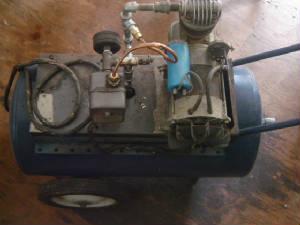
|
| The Junker Air Compressor |
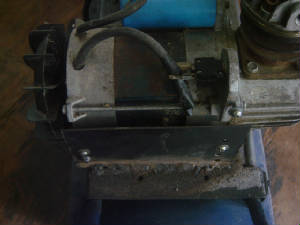
|
| Closeup of welded plate holding motor/compressor |
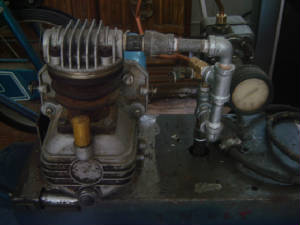
|
| Closeup of hardware on top of compressor tank |
|
